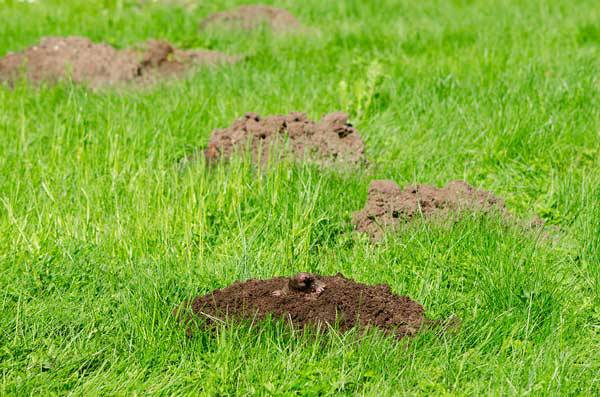A lot of us work hard to keep our yard and our landscape looking a certain way. It takes a lot of effort to get the lawn mowed at just the right length, or the shrubs and the flowers looking just so. After all this work the last thing you want to wake up to is a yard full of holes, tunnels, and mounds of dirt.
A lot of us work hard to keep our yard and our landscape looking a certain way. It takes a lot of effort to get the lawn mowed at just the right length, or the shrubs and the flowers looking just so. After all this work the last thing you want to wake up to is a yard full of holes, tunnels, and mounds of dirt. Our goal is to answer the following common questions about moles:
- What are the common signs of moles in yards?
- Why does your yard have moles?
- How do you keep moles out of yards?
Moles make their way into your yard looking for food. They eat insects, with their primary food source being earthworms. The downside to that is what they can do to your lawn and your landscaping in the process. Most people would choose other options when it comes to pest control than letting a mole tunnel around eating them up.
When it comes to your lawn pests, it can be helpful to know for sure what kind of critter is making the mess. There are some signs of moles in your yard so that you know you have moles in your lawn or not. This way when you need pest control for moles you can be sure you’re calling about the right creature. Moles are pretty impressive as far as the amount of damage they can do and the time frame in which they can carry out their destructive habits.
Common Signs of Moles in Your Yard
- Surface Tunnels
- Dying grass and plants
- Increase in weeds
- Molehills
Moles can dig up to 18’ an hour. They build burrows deep underground and then dig temporary tunnels off those. Seldom is the same tunnel used more than once. These surface tunnels can be a definite sign of moles in your yard. When moles are digging their tunnels they detach the roots of plants. This not only allows weeds the opportunity to root, but it can kill your lawn, plants, and trees. These surface tunnels leave your lawn looking lumpy and raised. Another sign of moles in your yard are molehills. While molehills are much less common than tunnels, they can still be found. They are usually less than 6 inches tall and are often shaped like a football or a volcano.
Why Do I have Moles in My Yard?
Moles are in your lawn because you have a food source in your soil; most likely grubs or earthworms. Moles burrow their way into our yards, creating raised tunnels on the surface and stacking up dirt when they make exit holes. They do this in search of food. If your lawn has been attacked by grubs, and you’ve been seeing dead patches of grass, it is likely that moles have come to feast on those grubs. Moles need quite a bit of food to survive. A yard that has grubs will be more appealing than a yard that does not. If your lawn was healthy and free of dead patches, your soil is full of another creature moles love to feed on: earthworms. Healthy lawns have an abundance of earthworms, and moles can survive quite well on a steady diet of them.
How to Keep Moles Out of My Lawn
- Targeted removal of moles
- Ongoing monitoring of moles in your lawn
- Treating mole tunnels
No yard is completely free of bugs. Therefore, no yard is 100% resistant to bug-eating moles. You’re not going to be able to keep moles away by controlling the food sources that lure them into your yard. The only solution is targeted removal, ongoing monitoring, and the treatment of tunnels. But all of these should be done by an educated and experienced professional. A wildlife professional knows how to track moles, where to place traps, what baits to use, how to treat tunnels so that new moles don’t come to replace old moles, and how to monitor to ensure that all the moles on your property have been removed. This is a complex process that requires pest control training, specialized products and equipment, and real-world experience.
If you think you have a problem with moles on your property, you should contact a professional pest control company to help you take care of it. Attempting to get rid of moles on your own is not a task easily done. If this process sounds too complicated and dangerous to you, we strongly suggest you give the pros at Rottler a call today! Pest professionals, like those at Rottler Pest Solutions, know the safest, quickest and most effective ways to catch moles. While we are taking care of your mole problem we can also help you get your lawn back in shape so you’ll never even know moles were there!


